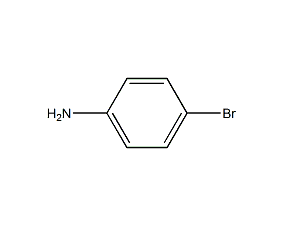
Structural formula
| Business number | 02TC |
|---|---|
| Molecular formula | C6H6BrN |
| Molecular weight | 172.02 |
| label |
1-Amino-4-bromobenzene, p-bromoaniline, p-Aminobenzene bromide, 4-bromoaniline, 4-amino-2-bromobenzene, 4-BROMOANILINE, 4-Bromoaniline, 98+%, 4-Bromanilinu, 4-bromanilinu(czech), 4-bromo-benzenamin, 4-bromobenzeneamine, Aniline, p-bromo-, Benzenamine, 4-bromo-, Benzenamine,4-bromo-, benzenamine,-bromo- |
Numbering system
CAS number:106-40-1
MDL number:MFCD00007822
EINECS number:203-393-9
RTECS number:BW9280000
BRN number:742031
PubChem ID:None
Physical property data
1. Properties: Colorless oblique needle-like crystals. Sensitive to light and air.
2. Density (g/mL, 25/4℃): 1.4970
3. Relative vapor density (g/mL, air=1): Undetermined
4. Melting point (ºC): 66~66.5
5. Boiling point (ºC, normal pressure): Undetermined
6. Boiling point (ºC, 5.2kPa): Undetermined Determined
7. Refractive index: Undetermined
8. Flash point (ºC): Undetermined
9. Specific rotation (º): Undetermined
10. Autoignition point or ignition temperature (ºC): Undetermined
11. Vapor pressure (kPa, 25ºC): Undetermined
12. Saturation Vapor pressure (kPa, 60ºC): Undetermined
13. Heat of combustion (KJ/mol): Undetermined
14. Critical temperature (ºC): Undetermined
15. Critical pressure (KPa): Undetermined
16. Log value of oil-water (octanol/water) partition coefficient: Undetermined
17. Explosion upper limit (% , V/V): Undetermined
18. Lower explosion limit (%, V/V): Undetermined
19. Solubility: Easily soluble in ethanol and ether, insoluble in cold water.
Toxicological data
1. Acute toxicity: rat oral LD50: 456mg/kg; mouse oral LD50: 289mg/kg; mouse abdominal LD50: 248mg/kg;
2. Chronic toxicitySafety/carcinogenicity
Mouse dermal TDLo: 7200mg/kg/18W-I;
3. Mutagenicity
DNA from rat liver Synthesis test: 50μmol/L;
Ecological data
This substance is slightly hazardous to water.
Molecular structure data
1. Molar refractive index: 38.17
2. Molar volume (cm3/mol): 107.8
3. Isotonic specific volume (90.2K ): 183.6
4. Surface tension (dyne/cm): 47.7
5. Dielectric constant:
6. Dipole moment (10-24cm3):
7. Polarizability: 15.13
Compute chemical data
1. Reference value for hydrophobic parameter calculation (XlogP): None
2. Number of hydrogen bond donors: 1
3. Number of hydrogen bond acceptors: 1
4. Number of rotatable chemical bonds: 0
5. Number of tautomers: none
6. Topological molecule polar surface area 26
7. Number of heavy atoms: 8
8. Surface charge: 0
9. Complexity: 66.9
10. Number of isotope atoms: 0
11. Determine the number of atomic stereocenters: 0
12. Uncertain number of atomic stereocenters: 0
13. Determine the number of chemical bond stereocenters: 0
14. Number of uncertain chemical bond stereocenters: 0
15. Number of covalent bond units: 1
Properties and stability
Avoid contact with strong oxidizing agents.
Storage method
Stored in a cool, ventilated warehouse. Keep away from fire and heat sources. Keep sealed. They should be stored separately from oxidants and acidic substances, and avoid mixed storage. Equipped with the appropriate variety and quantity of fire equipment. Suitable materials should be available in the storage area to contain spills.
Synthesis method
Use p-nitroaniline as raw material, undergo diazotization and bromination to obtain p-bromonitrobenzene, and then reduce it with iron powder.
Purpose
This product is used to prepare dihydroquinolazole. Also used in other organic synthesis and the manufacture of azo dyes.


